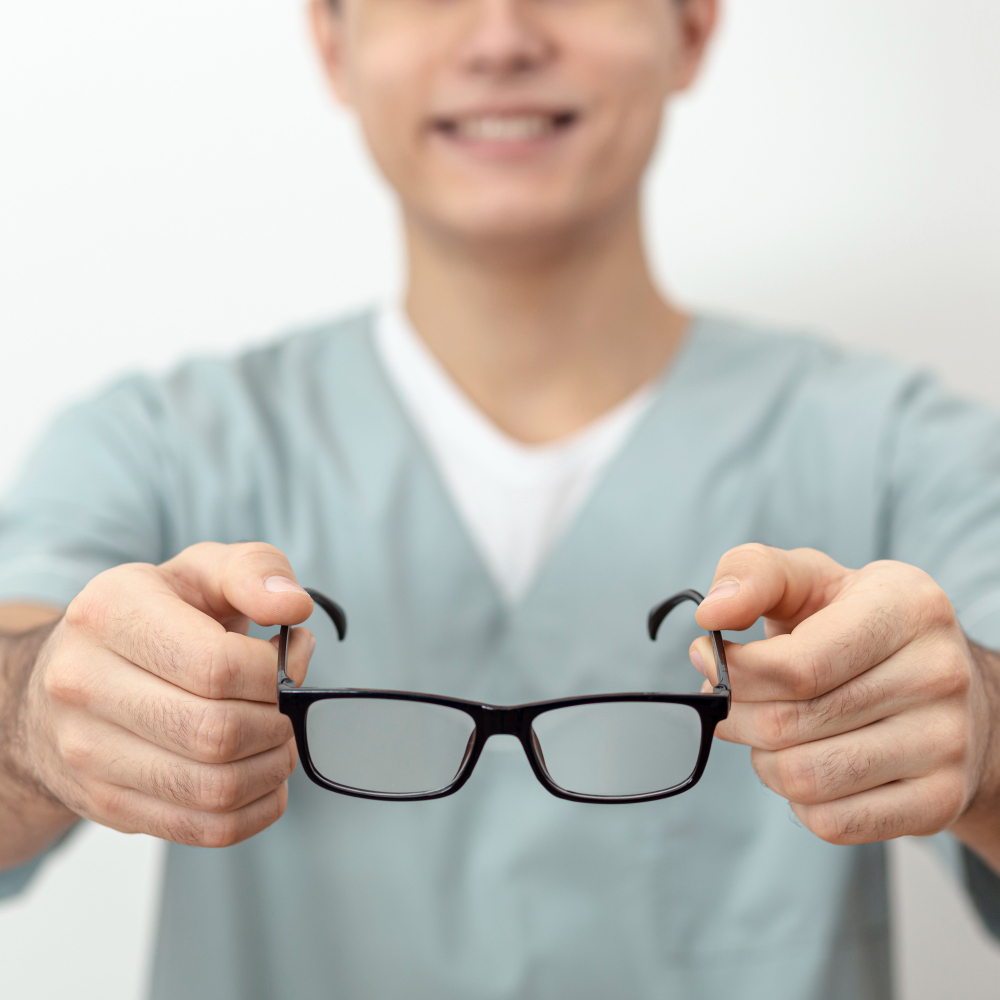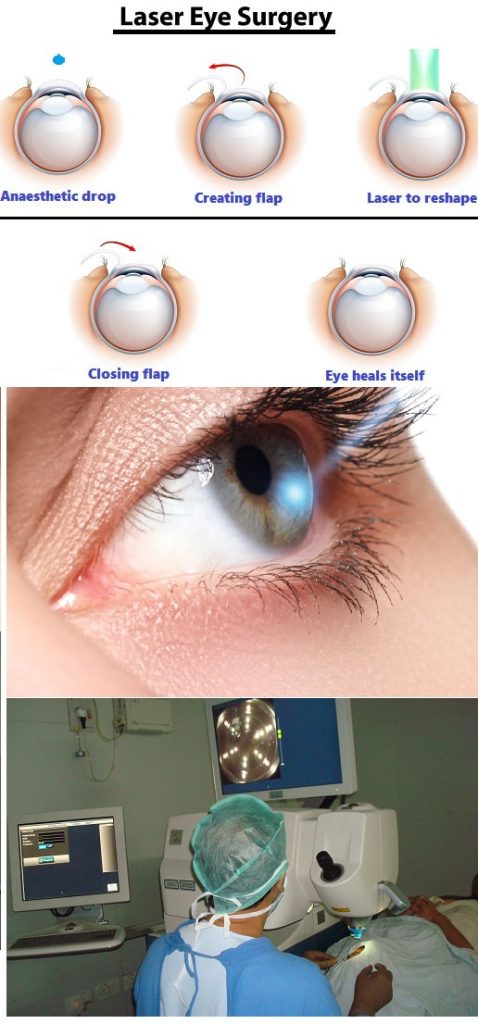Vision Correction
Vision Correction Methods
There are various vision correction methods that include different techniques based on the patient’s health and vision condition. These methods include laser surgery such as LASIK, lens implantation and replacement surgeries, as well as newer techniques like Femto LASIK and Femto SMILE. The suitable method is chosen based on multiple factors such as corneal thickness, the degree of myopia or hyperopia, and the presence or absence of other eye diseases.
How Are Vision Correction Surgeries Performed?
Vision correction surgeries are conducted in specialized hospitals under the supervision of a qualified ophthalmologist. These surgeries are typically quick, lasting about 5 to 10 minutes. Local anesthesia is applied to the eye, and the doctor uses a laser or precise surgical tools to reshape the cornea or to perform lens implantation or replacement. The goal is to correct visual impairments such as myopia, hyperopia, or astigmatism.

Vision Correction with LASIK Technique
LASIK is one of the most common vision correction techniques. The procedure involves reshaping the cornea with a laser. This technique is very effective in correcting myopia, hyperopia, and astigmatism. The advantage of LASIK lies in the quick recovery and the ability to return to daily activities promptly.
Vision Correction Using PRK Laser Technique
PRK is an older form of laser surgery that involves removing the outer layer of the cornea before using the laser to reshape the cornea. The healing process might be slightly longer compared to LASIK, but it’s a good option for individuals with thin corneas or activities that may expose the eye to injuries.
FemtoLASIK Vision Correction
This technique is similar to LASIK but uses the FemtoLASIK device, making the procedure less invasive and potentially reducing certain risks compared to traditional LASIK

Custom LASIK and Custom FemtoLASIK
These techniques use patient-specific data to achieve the best possible results. Detailed data about the shape and imperfections of each patient’s cornea are collected to guide the laser more precisely in correcting the defects, improving outcomes and reducing risks.
SMILE Vision Correction Surgery
SMILE is an emerging technique that uses femtosecond laser to make precise cuts in the cornea, allowing for the removal of a small portion of corneal tissue to correct vision. Femto SMILE is characterized by minimal cutting and rapid healing.
Intraocular Lens Implantation (ICL)
This method involves implanting artificial lenses inside the eye to correct vision impairments. It is a popular alternative for individuals who are not suitable candidates for laser surgery.
Refractive Lens Exchange (RLE)
This procedure involves replacing the eye’s natural lens with an artificial one, often used to treat severe farsightedness and nearsightedness, or presbyopia (age-related loss of near vision).
Criteria for Laser Vision Correction
To undergo laser eye surgery, a patient must be an adult with stable vision for at least a year. The cornea must be thick enough, and the eye must be free of diseases such as keratitis. Also, the patient should not be pregnant or breastfeeding.
Factors Preventing Vision Correction
These factors include overly thin corneas, a history of eye diseases like glaucoma or keratitis, pregnancy, breastfeeding, or unstable vision. Certain medical conditions like uncontrolled diabetes may increase risks.
Steps in Laser Vision Correction Procedure
The process begins with a comprehensive eye exam to determine the patient’s suitability for surgery. On the day of the procedure, the eyes are numbed with topical drops. The surgeon performs the laser correction, and after the procedure, protective drops are applied, and rest is recommended for a few days.
Duration of Vision Correction Surgery
Most vision correction surgeries are quick, taking about 5 to 10 minutes. However, patients may need to spend additional time for preparation and recovery in the clinic or hospital.
Possible Risks of Vision Correction Surgery
Laser vision correction surgeries, such as LASIK and FemtoLASIK, are generally safe but not without risks. Complications may include infection, dry eyes, decreased night vision quality, and glare. In rare cases, patients may experience a permanent reduction in vision quality, which may require glasses or contact lenses for correction. Most issues can be treated with medication or a secondary laser procedure.
Potential Downsides of Laser Vision Correction
Despite the positive outcomes of laser vision correction surgeries, there are some downsides to consider. Some patients may experience difficulties such as halos around lights at night, dry eyes, and even vision changes that require additional treatments. Healing may take time and requires special care.
What to Expect After Vision Correction Surgery?
After vision correction surgery, patients may experience mild discomfort, dry eyes, or blurry vision for a short period. Vision typically improves within the first day after surgery and continues to improve over the next few weeks. It is crucial to follow the doctor’s eye care instructions and attend all follow-up appointments.


Pre-Surgery Guidelines for Vision Correction
It is important to refrain from wearing contact lenses for a specified period before the surgery and to avoid using any cosmetics or products that could affect the eyes. Any medications or health conditions should be discussed with the doctor, and all instructions should be followed precisely.
Post-Surgery Tips for Vision Correction
After the procedure, patients should avoid rubbing their eyes and direct exposure to bright light. The doctor may prescribe eye drops to prevent infection and reduce inflammation. It is also important to attend follow-up sessions to ensure proper healing.
Laser Vision Correction Costs in Egypt
The costs vary based on the type of surgery and the medical center. Typically, they range from several thousand Egyptian pounds, and may increase in more advanced centers.
Is it Possible to Redo Vision Correction Surgery?
Yes, in some cases, the surgery can be redone, especially if the initial results were not satisfactory or if the need for vision correction changes over time.
Success Rate of Vision Correction Surgery
Laser vision correction surgeries like LASIK and FemtoLASIK have very high success rates, with studies indicating over 90% of cases achieving 20/20 vision or close to it. This means that most people who undergo these surgeries end up with clear vision that allows them to perform most of their daily activities without glasses or contact lenses. However, it’s important to note that results can vary depending on individual cases, and the surgery may not be suitable for everyone.
Recovery Time After FemtoLASIK Surgery
After FemtoLASIK surgery, patients can expect relatively quick vision recovery. Typically, patients start noticing an improvement in vision within 24 to 48 hours after the surgery. However, it may take several weeks for full vision stabilization. During this period, some patients may experience minor fluctuations in vision, which is normal within the healing process.
Eligible Age for Vision Correction Surgery
The ideal age for laser vision correction surgery is usually after vision stabilization, which typically occurs around 18-20 years of age. It’s important for the individual to have maintained a stable glasses or contact lens prescription for at least a year before the surgery. There is no maximum age limit, but the eyes must be healthy and free from diseases like glaucoma or cataracts.
Vision Correction for People Over Forty
For individuals over forty, there may be a need to correct presbyopia (age-related reading difficulty) in addition to any other refractive errors. Multifocal lenses or surgeries targeting both eyes in different ways (such as monovision) might be possible options. These options should be carefully discussed with the treating physician.
Pros and Cons of Vision Correction Surgery
The advantages include improved quality of life with clear vision without the need for glasses or contact lenses, and quick results and recovery. The downsides may include risks like dry eyes, glare and halos, and, rarely, fluctuations in vision or the need for subsequent corrective surgeries.
Working Hours
Saturday
7 pm to 9 pm
Sunday
7 pm to 9 pm
Monday
7 pm to 9 pm
Tuesday
7 pm to 9 pm
Wednesday
7 pm to 9 pm
Thursday
Closed
Friday
Closed
Ramadan Working Hours
Saturday to Wednesday from 9 pm to 11 pm
Location
21st Ismail Ramzy st. – El-Bostan – Heliopolis – 4th floor
01110114354
01222422637
0226331026
(7 pm to 9 pm)
Make Appointment
Always happy to receive your inquiries
